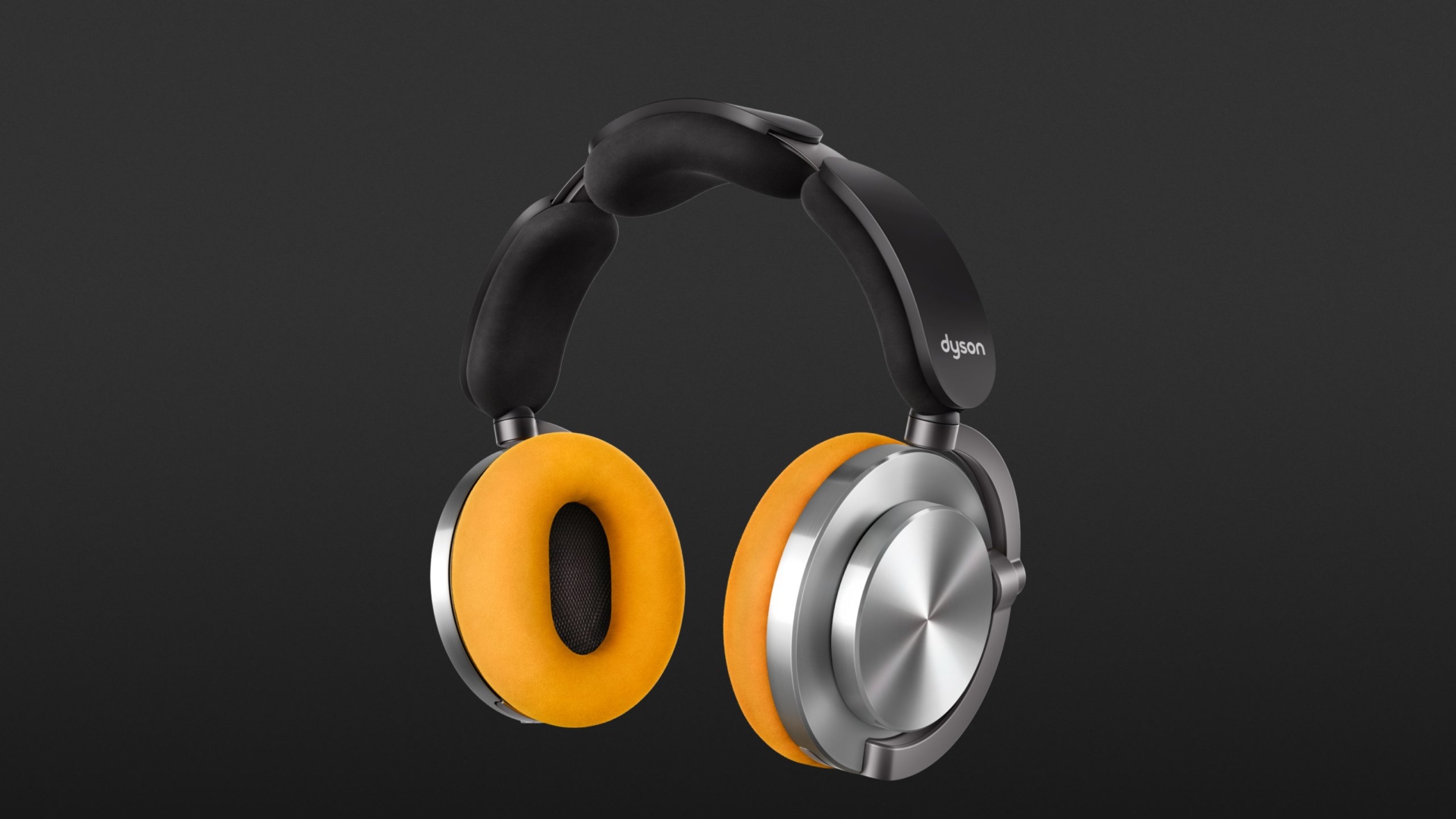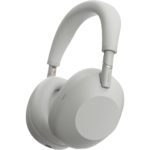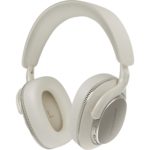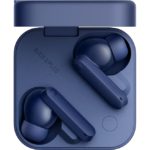The Dyson OnTrac impressed us with excellent workmanship, customised design and long battery life. However, there are even cheaper headphones that offer more functions and more modern technology. On the other hand, the noise cancelling worked excellently. Design lovers who value customisation options will appreciate the OnTrac but will have to be ready to make additional investments to get accessories.
- Effective noise cancelling
- Good sound
- Comfortable to wear
- Customisable colours
- Bluetooth 5.0
- No multipoint
- App could be improved
- Sweaty ears in summer
- Status tones cannot be switched off
The Dyson Zone is certainly one of the most unusual headphones of recent years and was also the first headphones from the technology company who have their headquarters in Malmesbury, UK. The concept was particularly unusual: headphones that have an air purification function thanks to the addition of a flip-down visor. As unusual as this concept was, it was also controversial.
It is therefore not surprising that Dyson has used this experience to produce another headset following the release of the Zone. And this new one goes by the name of “OnTrac”.
Dyson OnTrac Quick Facts
- What is the Dyson OnTrac?
The Dyson OnTrac are Bluetooth over-ears with hybrid noise cancelling. - What’s special about the Dyson OnTrac?
The Dyson OnTrac are available in four basic colours/designs (CNC copper, CNC aluminium, CNC nickel and ceramic vermilion) and can be customised thanks to additional colourful ear pads and capsules. They are also a proper endurance runner: with a runtime of 55 hours when noise cancelling is activated, they are currently one of the best headphones on the market for battery life. - How much do the Dyson OnTrac cost?
The Dyson OnTrac have a recommended retail price of 499 euros. - What Dyson OnTrac accessories are available and how much do they cost?
A pair of ear pads and capsules cost 49 euros each and can be ordered directly from Dyson. An original USB-C to mini jack cable, including an aeroplane adapter, costs around 30 euros.
The differences: Dyson OnTrac vs. Dyson Zone
The Dyson OnTrac is a completely “normal” headset. The Dyson Zone, on the other hand, has the aforementioned air purification system, including filters and fans on the ear cups with a removable visor for air supply.
The technology – what does the Dyson OnTrac have built-in?
- Frequency response: 6 Hz – 21kHz
- Driver: 40mm, angled at 13 degrees, dynamic, neodymium
- Distortion: 0.2% @ 94dB 1kHz
- Impedance: 16 Ohm
- USB-C audio: analogue yes; digital no
- ANC: hybrid noise cancelling, 8 microphones
- Transparency mode: yes
- Carrying detection (Auto Pause): Yes
- Bluetooth version: 5.0
- Bluetooth codecs: SBC, AAC, LHDC
- Bluetooth profiles: A2DP, AVRCP, HFP
- Multipoint: No
- Battery: 2x lithium-ion batteries in the headband (2,540 mAh each)
- Operating time: 55 hours with ANC
- Charging time: 3 hours charging 55 hours; 10 min charging 2.5 hours; 30 min charging 9.5 hours
- App connection: Yes, iOS and Android
- Telephony: 1 microphone
- Controls: touch, joystick, push button
Package
The Dyson OnTrac’s package is very spartan: A case and a fabric-covered USB-C charging cable are included – nothing more. The case has a special feature: the two sides are connected with a neoprene-like fabric, which is thin and stretchy. This reduced the case to around two centimetres in height after removing the headphones, and this proved to be extremely space-saving when I was travelling with a backpack. This transport case and the charging cable have a high-quality finish.
However, I have some criticism: For just under 500 euros, other premium manufacturers also include a USB-C to mini jack cable with an aeroplane adapter. But, if you’re travelling by plane with the Dyson OnTrac, you’ll have to dig deeper into your pockets for extra accessories.
Design and workmanship: unmistakably Dyson
While many headphones can seem rather plasticky and cheap looking, even in this price range, Dyson really delivers quality: The OnTrac adhere to the company’s design language and they are very well made: Perfect gap dimensions, polished aluminium and an almost timeless appearance.
A closer look reveals similarities to the previous model, the Zone: The headband and the capsule suspension have been adopted 1:1. And why not?
You can customise the colour scheme, but because the OnTrac has a modular design: Both the ear pads and the capsules can be removed and replaced with a twist. The sets cost 49 euros each and you can choose from seven ear pads colours (Chrome Yellow, Cinnabar, Oyster Pink, Khaki, Ultra Blue, Prussian Blue, Dark Iron) and capsules (CNC Copper, Ceramic Cinnabar, Ceramic Khaki, Ceramic Blue, Coarse Titanium, CNC Black Nickel, CNC Aluminum) to create your own designs. Depending on the colour combination you choose, you will get headphones that can be flexibly adapted to become everything from understated to trendy. Is this a gimmick? Of course, but ultimately, everyone has to decide for themselves. At least the OnTrac stand out from the standardised black of many competitors in a refreshing fashion.
Very good battery life
As with the Zone, Dyson has integrated the batteries into the two side pads of the headband. This offers two decisive advantages: The batteries can be larger, which explains the long running time of 55 hours, including noise cancellation. It also makes the pods themselves narrower and lighter, which reduces the strain on your ears.
Dyson OnTrac – what works and what doesn’t?
As stylish as the OnTrac may be, I can’t really understand some of the manufacturer’s decisions. Firstly, there is the older Bluetooth version 5.0. While some inexpensive headphones still rely on version 5.3, Sennheiser etc. already come with version 5.4 including LE and Auracast support. You can find out exactly what this means in our guides.
Unfortunately, Multipoint is missing.I think that in the age of laptops, tablets and smartphones, it is certainly something that is needed: if you’re streaming a film on your tablet and your smartphone is ringing, with Multipoint you can switch seamlessly between film and phone call.
Some features were also missing in the:
MyDyson app
When we tested the Dyson OnTrac, the equaliser section of the MyDyson app (iOS and Android) consisted of three pre-sets – “Optimised”, “Bass Boost” and “Neutral”. According to the manufacturer, a 5-band EQ that allows you to make manual adjustments will be added with an update.
Other than that, the app’s options are still very limited: You can set the ANC mode (“ANC”, “Transparency”, “Off”) and switch off head detection. That means that Auto Pause no longer works, automatic switch-off is deactivated, automatic muting during calls no longer works, and the status LED and sounds are switched off. However, it has not been implemented consistently enough. This is because the tones still sound when the ANC is switched on. Incidentally, these are volume-dependent, which caused me to be startled more than once during the test period when the headphones were turned up and playback was paused. You can also limit the playback volume to 80 dB in the app.
In typical Dyson fashion, the headphones measure the noise level of your surroundings and how loud it is under the headphones. Both these pieces of information are displayed as a curve or over time and grouped into individual days. Only the last eight days are recorded; there is no export function.
If you like facts, figures and measured values (like the author of this review), you will find these kinds of interesting facts from the world of (ambient) noise in the app. It was interesting when the curve suddenly turned red and almost 100 dB were measured. The reason for this: eating a biscuit! So, chewing a biscuit produces volumes that are alarmingly high. This proves that biscuits are unhealthy, and not just because of their sugar content.
The Dyson OnTrac cannot measure the nitrogen dioxide content of the air, even though the words “Air Quality Sensor” are labelled under the left ear cup. Perhaps a feature for the future?
How good is the ANC and transparency mode of the Dyson OnTrac?
The passive noise cancellation of the comfortable ear pads is already at a high level. For the active version, the Dyson OnTrac uses eight microphones to pick up environmental noise 384,000 times per second.
In practice, this means that the hybrid noise cancelling works very effectively. The noise cancelling absorbs noise over a wide frequency range and ensures a pleasant silence. A background noise was perceptible and was only noticeable in silence or very quiet passages of music. You will hardly notice it on a noisy train or crowded platforms.
In a direct comparison with Apple AirPods Max, Bose QuietComfort Ultra headphones or Sony WH-1000XM5, the Dyson OnTrac was almost on a par and in some cases performed equally well. There were only slight differences between them all.
The transparency mode also worked very well, but the background noise was higher with the Dyson headphones due to the design. Ambient noise was passed through quite naturally, so fortunately, it didn’t sound artificial.
How good does the Dyson OnTrac sound?
You shouldn’t expect audiophile miracles; the Dyson OnTrac is tuned to be more “discreetly fun”. Although they worked quite unspectacularly in the neutral position, which was sometimes reminiscent of studio headphones, you would still be able to tell that these are a consumer wearable. The “Optimised” pre-set was set as standard, which made the bass and treble appear more present. Whether via LHDC or AAC, the OnTrac reproduced a wide range of genres in a way that was completely suitable for everyday use – even at high volumes, they did not distort. However, when turned up all the way, the sound was somewhat distorted and the upper mids sounded tired.
At a moderate volume, the mids were not overemphasised, which, together with the restrained treble range, allowed for hours of fatigue-free listening (e.g. Madonna’s “Jump”).
The virtual stage spread successfully from left to right, so that events could be tracked nicely. However, the depth graduation seemed relatively narrow, so it lacked precision under certain conditions (Amon Tobin “Goto 10”).
Dyson OnTrac – Conclusion
The Dyson OnTrac left me with a very good impression in terms of workmanship, design and customisation options. However, the latter applies above all to the personalisable colour design. Based on the current status of the features, however, it must also be clearly stated that there are other headphones out there that do more for less money – at least in terms of sound performance, the range of additional functions and technical substructure.
The Dyson OnTrac scored points for good sound and the hybrid noise cancelling does a very good job! And the same goes for the excellent battery life of 55 hours with (!) Activated Noise Cancellation.
The package was particularly impressive thanks to the clever transport case, but it was a shame that travellers have to buy the USB-C to mini-jack cable and aircraft adapter separately.
If you value design and appreciate such things, the OnTrac could be just right for you. However, the colour customisation will then require additional investment.
Technical specifications
- Ear couplingOver-ear
- Typeclosed
- Transducer principledynamic
- Frequency response (headphones)6 - 21.000 Hz
- Impedance16 ohms
- Weight without cable451 g
- Cable length150 cm
Special features
- Available in yellow/aluminium, midnight blue/copper, black/cinnabar and black/nickel
- Wide range of colour variations possible
- BT version: 5.0
- BT codecs: SBC, AAC, LHDC

















































